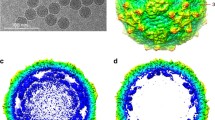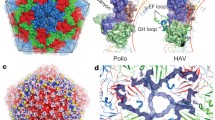Summary
We have determined the sequence for 1,000 bases from the 3′ terminus of a human astrovirus serotype 1 isolated in Newcastle. This is the first sequence reported for a representative of this virus family. We find one open reading frame which terminates 83 bases from a poly A tail. The 3′ non-coding-region has similarities to some picornavirus termini. However the amino acids specified by the coding region have no significant homology to the picornavirus protein 3D, encoded at the 3′ terminus of these viruses. Northern blot analysis of intracellular virus-specific RNAs revealed one size of transcript which corresponded to full-length virus RNA. Available data thus indicate that astroviruses may resemble picornaviruses in replication strategy.
Similar content being viewed by others
References
Auvinen P, Hyypia T (1990) Echoviruses include genetically distinct serotypes. J Gen Virol 71: 2133–2139
Auvinen P, Stanway G, Hyypia T (1989) Genetic diversity of enterovirus subgroups. Arch Virol 104: 175–186
Barrett T, Wolstenholme AJ, Mahy BWJ (1979) Transcription and replication of influenza virus RNA. Virology 98: 211–225
Brosius J, Palmer ML, Kennedy PJ, et al (1978) Complete nucleotide sequence of a 16S ribosomal RNA gene fromEscherichia coli. Proc Natl Acad Sci USA 75: 4801–4805
Brosius J, Dull TJ, Noller HF (1980) Complete nucleotide sequence of a 23S ribosomal RNA gene fromEscherichia coli. Proc Natl Acad Sci USA 77: 201–204
Carter MJ (1990) Transcription of feline calicivirus RNA. Arch Virol 114: 143–152
Carter MJ, Milton ID, Turner PC, Meanger J, Bennett H, Gaskel RM (1992) Identification and sequence determination of the capsid protein gene of feline calicivirus. Arch Virol 122: 223–235
Chang KH, Auvinen P, Hyypia T, et al (1989) The nucleotide sequence of Coxsackie A9; implications for receptor binding and enterovirus classification. J Gen Virol 70: 3269–3280
Feinberg AP, Vogelstein B (1984) A technique for radiolabelling DNA restriction endonuclease fragments to high specific activity. Anal Biochem 137: 266–267
Gough RE, Collins MS, Borland E, et al (1984) Astrovirus-like particles associated with hepatitis in ducklings. Vet Rec 114: 279
Grunstein M, Hogness DS (1975) Colony hybridization: a method for the identification of cloned DNAs that contain a specific gene. Proc Natl Acad Sci USA 72: 3961–3965
Guber U, Hoffman BJ (1983) Simple and very efficient method for generating cDNA libraries. Gene 25: 263–269
Hanahan D (1985) Techniques for transformation ofE. coli. In: Glover DM (ed) DNA cloning, vol 1. IRL Press, Eynsham, Oxford, pp 109–135
Hassouna N, Michot B, Bachellerie JP (1984) The complete nucleotide sequence of mouse 28S rRNA gene. Implications for the process of size increase of the large subunit rRNA in higher eukaryotes. Nucleic Acids Res 12: 3563–3583
Henikoff S (1984) Unidirectional deletion with exonuclease III creates target breakpoints for DNA sequencing. Gene 28: 351–359
Herring AJ, Gray EW, Snodgrass DR (1981) Purification and characterization of ovine astrovirus. J Gen Virol 53: 47–55
Higgins DF and Sharp PM (1988) CLUSTAL: a package for performing multiple sequence alignment on a microcomputer. Gene 73: 237–244
Hughes PJ, North C, Minor PD, et al (1989) The complete nucleotide sequence of Coxsackie virus A21. J Gen Virol 70: 2943–2952
Kamer G, Argos P (1984) Comparison of RNA-dependent polymerases from plant, animal and bacterial viruses. Nucleic Acids Res 12: 7269–7282
Kurtz JB (1989) Astroviruses. In: Farthing MJG (ed) Viruses and the gut. Proceedings of the ninth BSG Smith Kline and French international workshop. Smith Kline and French Laboratories, Welwyn Garden City, Herts, pp 84–87
Kurtz JB, Lee TW (1984) Human astrovirus serotypes. Lancet ii: 1405
Kurtz JB, Lee TW (1987) Astroviruses: human and animal. In: Bock G, Whelan J (eds) Novel diarrhoea viruses. Wiley, Chichester, pp 92–107 (CIBA foundation symposium 128)
Lee TW, Kurtz JB (1981) Serial propagation of astrovirus in tissue culture with the aid of trypsin. J Gen Virol 57: 421–424
Lehrach H, Diamond D, Wozney JM, et al (1977) RNA molecular weight determinations by gel electrophoresis under denaturing conditions, a critical re-examination. Biochemistry 16: 4743–4751
Madeley CR, Cosgrove BP (1975) 28 nm particles in faeces in infantile gastroenteritis. Lancet ii: 451–452
Maniatis T, Fritsch EF, Sambrook J (1982) Molecular cloning. A laboratory manual. Cold Spring Harbour Laboratory, New York
Monroe SS, Stine SE, Gorelkin L, et al (1991) Temporal synthesis of proteins and RNAs during human astrovirus infection in cultured cells. J Virol 65: 641–648
Raynal F, Michot B, Bachellerie JP (1984) Complete nucleotide sequence of mouse 18S rRNA gene: comparison with other homologs. FEBS Lett 167: 263–268
Rueckert RR (1991) Picornaviruses and their replication. In: Fields BN, Knipe DM (eds) Fundamental virology. Raven Press, New York, pp 409–450
Ryan MD, Jenkins O, Hughes PJ, et al (1990) The complete nucleotide sequence of enterovirus type 70: relationships with other members of the Picornaviridae. J Gen Virol 71: 2291–2299
Tohya Y, Taniguchi Y, Takahashi E, et al (1991) Sequence analysis of the 3′-end of feline calicivirus genome. Virology 183: 810–814
Willcocks MM, Carter MJ, Laidler FR, et al (1990) Growth and characterization of human faecal astrovirus in a continuous cell line. Arch Virol 113: 73–82
Woode GN, Bridger JC (1978) Isolation of small viruses resembling astroviruses and caliciviruses from acute enteritis of calves. J Med Microbiol 11: 441–452
Wreschner DH, Herzberg M (1984) A new blotting medium for the simple isolation and identification of highly resolved messenger RNA. Nucleic Acids Res 12: 1349–1359
Author information
Authors and Affiliations
Rights and permissions
About this article
Cite this article
Willcocks, M.M., Carter, M.J. The 3′ terminal sequence of a human astrovirus. Archives of Virology 124, 279–289 (1992). https://doi.org/10.1007/BF01309809
Received:
Accepted:
Issue Date:
DOI: https://doi.org/10.1007/BF01309809




